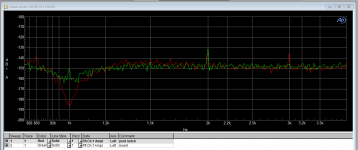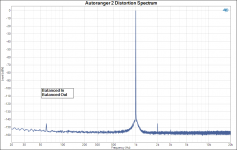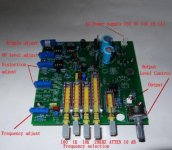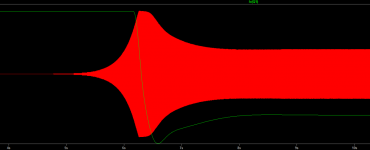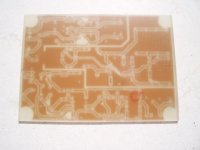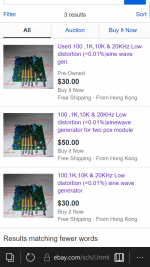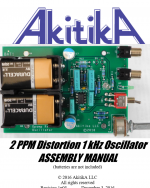Thanks Edmond
I haven't used DiAna, maybe its time to give it a try. Where is a reputable place to download it?
Haven't been down to the workshop yet to try out this with ARTA, but sent Ivo a question via his web site. - I've helping my son paint his new apartment. 🙂
Cheers
Mike
Hi Mike,
You can download it here: Index of /diana/ The password for unzipping is: Yohimbine
Look here for a brief (and incomplete) description: DiAna
More info can be found here: DiAna, a software Distortion Analyzer
Cheers,
E.
Made some more tests with the tracking filter today.
My operating assumption was that ultimately the self-distortion of the 2722 generator and analyzer are limiting its performance. And, when I would attenuate the fundamental by 40dB, the AP will 'think' that the distortion is 40dB higher than what it really is, and that distortion will then be visible above the AP internal distortion. Then I subtract 40dB from the shown value and Bob's my uncle. So far so good.
But that will not work if the filter circuitry also generates distortion at a similar level as the AP. Then, taking out the fundamental will just make me see better the internal distortion of the notch.
The attached shows two curves, input (insert, green) and output (post notch, red) of the notch filter. Very little difference, but you can see that the notch works as shown by deeper cancellation of the 1kHz.
Both curves with auto-ranging disabled, both with same AP gain setting. My conclusion is that I am really measuring the distortion of the opamps and passive parts in the tracking notch filter. I have done this measurement with and without the tracking (shorted linear optocoupler) with no differences, so at this point the tracking mechanism does not cause any distortion.
Now that the tracking has proven itself I should go and work on making the notch filter itself very low distortion.
Groner/Polak opamp come to mind, but in the AR I have also seen extremely low distortion from an OPA1688.
It never ends ... 🙄
Jan
My operating assumption was that ultimately the self-distortion of the 2722 generator and analyzer are limiting its performance. And, when I would attenuate the fundamental by 40dB, the AP will 'think' that the distortion is 40dB higher than what it really is, and that distortion will then be visible above the AP internal distortion. Then I subtract 40dB from the shown value and Bob's my uncle. So far so good.
But that will not work if the filter circuitry also generates distortion at a similar level as the AP. Then, taking out the fundamental will just make me see better the internal distortion of the notch.
The attached shows two curves, input (insert, green) and output (post notch, red) of the notch filter. Very little difference, but you can see that the notch works as shown by deeper cancellation of the 1kHz.
Both curves with auto-ranging disabled, both with same AP gain setting. My conclusion is that I am really measuring the distortion of the opamps and passive parts in the tracking notch filter. I have done this measurement with and without the tracking (shorted linear optocoupler) with no differences, so at this point the tracking mechanism does not cause any distortion.
Now that the tracking has proven itself I should go and work on making the notch filter itself very low distortion.
Groner/Polak opamp come to mind, but in the AR I have also seen extremely low distortion from an OPA1688.
It never ends ... 🙄
Jan
Attachments
Last edited:
Share the link? Did they pose a schematic? if its not totally hosed up it may be a solid base for tweaking. The trims suggest its pretty sophisticated.
Low distortion(0.01%) sine wave generator (oscillator) | eBay
Just search on ebay.com (not the other ebays) for "low distortion oscillator" and you'll find a few kits. This is one.
Just search on ebay.com (not the other ebays) for "low distortion oscillator" and you'll find a few kits. This is one.
Yesterday I made some modifications to Victor's oscillator. The AGC is now much calmer and more solid. The circuit has now developed more in the direction of Linear Technology' ;-)
The red curve is from post notch. Right? Where does the harmonic at 3 kHz come from? From the notch filter itself?
Made some more tests with the tracking filter today. <snip>
The red curve is from post notch. Right? Where does the harmonic at 3 kHz come from? From the notch filter itself?
Attachments
Yesterday I made some modifications to Victor's oscillator. The AGC is now much calmer and more solid. The circuit has now developed more in the direction of Linear Technology' ;-)
Does Victor agree?
Jan
The red curve is from post notch. Right? Where does the harmonic at 3 kHz come from? From the notch filter itself?
I wish I knew. I do know that the AP analyzer has such a 3rd residual, so I'm thinking it is that.
I am revising the notch circuitry to thy to get less residual and less noise. All circuitry is now inverting to avoid any CM distortion, and signals to the (non-linear) frequency and phase discriminators are now buffered.
As I said, it goes on and on ...
Jan
Does Victor agree?
Jan
Yeah, it looks like it was simulated in LTSpice. I’d want to measure to make sure it’s actually an improvement.
If someone comes along and tosses out a quick and easy improvement for something that has been optimized over several years, I am not holding my breath 😎
Jan
Jan
Yesterday I made some modifications to Victor's oscillator. The AGC is now much calmer and more solid. The circuit has now developed more in the direction of Linear Technology' ;-)
Also in my head 😀
. Do use polypropylene caps
. Replace the noisy TL072 opamp
. May test the new TI opa1656 opamp
Do you share the AGC mod's and how the THD alters🙄
Hp
I ordered one. But I see two for $50. That would have been better deal $25 each.
100 ,1K,10K & 20KHz Low distortion (<0.01%)sinewave generator for two pcs module | eBay
100 ,1K,10K & 20KHz Low distortion (<0.01%)sinewave generator for two pcs module | eBay
Attachments
The settling time and distortion are linked.If someone comes along and tosses out a quick and easy improvement for something that has been optimized over several years, I am not holding my breath 😎
Jan
OPA1656: Nice new toy. Will give it a try after my Mouser christmas pack has been arrived.. May test the new TI opa1656 opamp
Not sure about this one either ?
It does show schematic in assy manual. Cost much more than Hk assy.
At $80 but if the Hk board does not work out may look at getting this one.
1 kHz Oscillator
It does show schematic in assy manual. Cost much more than Hk assy.
At $80 but if the Hk board does not work out may look at getting this one.
1 kHz Oscillator
Attachments
Last edited:
The settling time and distortion are linked.
Normal or inverse?
Jan
Normal or inverse?
Jan
Faster settling time usually means more distortion. This is because the agc control circuit is a high-order nonlinear feedback system. The filtering needed to suppress the agc level detect rectification ripple introduces poles and phase lag, leading to instability in the agc loop. Some HP oscillators used to have a switch on the back where you could choose lowest distortion or fastest settling time for low frequencies.
Cheers,
Bob
The plastic case is not a good idea. Okay for hobby measurements, but not for professional requirements.Not sure about this one either ?
It does show schematic in assy manual. Cost much more than Hk assy.
At $80 but if the Hk board does not work out may look at getting this one.
1 kHz Oscillator
Unless treated with The Art of Spraying Electrically Conductive Paints | Parker Chomerics . Like e.g. the internal side of EMU 0404 USB plastic case. Covering all the internal side with copper tape made basically no difference in noise figure. The original sprayed layer measured 30R resistance from side to side with regular MM probes.
- Home
- Design & Build
- Equipment & Tools
- Low-distortion Audio-range Oscillator
